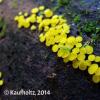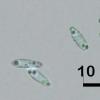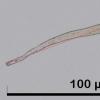
19-12-2025 10:10
Patrice TANCHAUDBonjour, récolte réalisée en milieu dunaire, a

18-12-2025 17:23
 Bruno Coué
Bruno Coué
Bonjour,je serais heureux d'avoir votre avis sur c

18-12-2025 21:17
Pol DebaenstThe identification took me to Byssonectria deformi

18-12-2025 18:07
Margot en Geert VullingsThese plumes were found on rotten wood.They strong

17-12-2025 18:35
 Michel Hairaud
Michel Hairaud
Bonjour à tous/Hi to everyone I am passing along

15-12-2025 15:48
 Danny Newman
Danny Newman
Melanospora cf. lagenaria on old, rotting, fallen

15-12-2025 15:54
 Johan Boonefaes
Johan Boonefaes
Unknown anamorph found on the ground in coastal sa

15-12-2025 21:11
 Hardware Tony
Hardware Tony
Small clavate hairs, negative croziers and IKI bb

15-12-2025 07:09
 Danny Newman
Danny Newman
indet. Rutstroemiaceae sp. on unk. fallen leavesMc
Discomycetes
Claude Kaufholtz-Couture,
26-10-2014 16:45
Mon étude préliminaire m'indique qu'il ne s'agit pas de Bisporella citrina.
Que dois-je rechercher exactement pour m'aider à trouver le nom de cette espèce ?
Sporée blanchâtre
Spores cylindriques, fusiformes à subbacilliformes, lisses, à paroi mince, n'ayant aucun septum, l'appendice hilaire non visible, à contenu guttulées à biguttulées, verdâtres dans le NaCl isotonique 0,9 %, inactives dans le Melzer, cyanophiles
7,4 [8,8; 9,4] 10,7 x 2,7 [3,1; 3,2] 3,5 µm
Q = 2,3 [2,8; 3] 3,5; N = 30; C = 95%
Me = 9,1 x 3,1 µm; Qe = 2,9
Je vous remercie !
Claude
Hans-Otto Baral,
26-10-2014 18:01

Re : Discomycetes
Bonjour Claude
Maybe you expected to see septate spores? The septum is formed in Bisporella citrina only on overmature spores, so don't worry. If the excipulum is gelatinized I am quite sure it is this species. You can also look at the ascus apex in IKI, but you need dead asci for that. The apical ring is a bit like a T, while for instance in Bisporella subpallida it is only reactive in the lower part of the wall thickeningl like two short thin lines, Also the contents of the paraphyses are worth to look at.
The difference in apicla ring and genetic data led me to say Calycina citrina for the present fungus, so I restrict Bisporella to B. subpallida and B. pallescens.
Zotto
Maybe you expected to see septate spores? The septum is formed in Bisporella citrina only on overmature spores, so don't worry. If the excipulum is gelatinized I am quite sure it is this species. You can also look at the ascus apex in IKI, but you need dead asci for that. The apical ring is a bit like a T, while for instance in Bisporella subpallida it is only reactive in the lower part of the wall thickeningl like two short thin lines, Also the contents of the paraphyses are worth to look at.
The difference in apicla ring and genetic data led me to say Calycina citrina for the present fungus, so I restrict Bisporella to B. subpallida and B. pallescens.
Zotto




